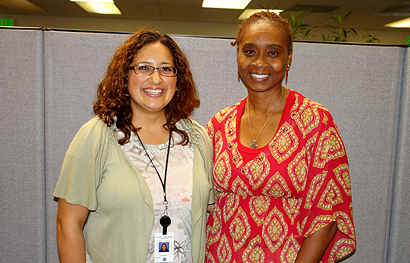Line Dancing to Live Well
/
There is no Cheryl Burke of Dancing with the Stars, but Josephine Subido, Josephine Velasco and Crystal French are star choreographers of the line dancing group at the County’s Health and Human Services Agency (HHSA) complex on Rosecrans Street.
These three and their group of about 15 dancers have no aspirations of appearing on the popular TV show but the group, which was created six months ago, dances for 15 minutes five days a week because they love dancing and it helps them to reduce stress and stay healthy.
“I love to dance,” said Subido, an account clerk with HHSA’s Maternal, Child and Family Health Services. “Instead of just sitting around during our break we started dancing. It’s a fun way to exercise,” she added.
For French, a microbiologist in the Public Health Lab, the line dancing allows her to interact and build relationships with employees from other departments in the building. Employees from eight different programs have joined the group.
“It’s fun and a stress relief,” said French after helping the group return the tables and chairs in the cafeteria to their normal position. “I feel much better after this.”
Two years ago, the County embarked on a 10-year campaign to improve the health and wellbeing of area residents and our own employees. One of the goals of the Live Well, San Diego! initiative is to encourage people to become more physically active, start eating healthier and stop smoking.
Those three behaviors are the main causes of four chronic diseases -heart disease/stroke, cancer, type 2 diabetes, and respiratory conditions such as asthma. In turn, those conditions are responsible for more than 50 percent of local deaths. County Public Health officials refer to it as the 3-4-50 program.
“These diseases can be prevented. Avoid smoking, eat fruits and vegetables, limit your fat and alcohol intake, and strive to be physically active every day.” said Wilma Wooten, M.D., M.P.H, County Public Health Officer. “Sometimes a few lifestyle changes can make the difference.”
The line dancers have heeded the County’s message and another group in the same building gathers to do yoga on a regular basis. Several employee exercise groups have been established in other buildings throughout the County.
“I share my dance steps with my colleagues because I am concerned about our health and fitness,” said Velasco, an account clerk with HHSA’s Office of Vital Records and Statistics. “We need an outlet outside of the office to release stress or to get some physical activity and share our joy of dancing. We really enjoy our breaks together.”
The Centers for Disease Control and Prevention recommends 150 minutes of moderate to intense activity each week. The 2.5 hours may seem like a lot but people can exercise in small increments of time.
The group is aware of this recommendation and complements their dancing by walking seven times around the building—the equivalent of one mile—during their 15-minute morning break.
The benefits of their daily exercise have started to show. Subido has lost eight pounds, French seven and Velasco six. Overall, the group has lost an average of six pounds.
“We’re not only having fun but losing weight,” concluded Subido.
To learn more about 3-4-50, visit Live Well, San Diego!


